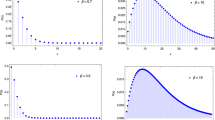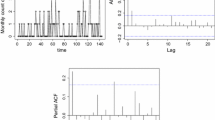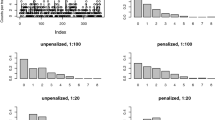Abstract
The first-order Poisson autoregressive model may be suitable in situations where the time series data are non-negative integer valued. In this article, we propose a new parameter estimator based on empirical likelihood. Our results show that it can lead to efficient estimators by making effective use of auxiliary information. As a by-product, a test statistic is given, testing the randomness of the parameter. The simulation values show that the proposed test statistic works well. We have applied the suggested method to a real count series.


Similar content being viewed by others
References
Al-Osh MA, Aly EEAA (1992) First order autoregressive time series with negative binomial and geometric marginals. Commun Stat Theory Methods 21:2483–2492
Al-Osh MA, ALZAID AA (1987) First-order integer-valued autoregressive (INAR(1)) process. J Time 8:261–275
Alzaid A, Al-Osh M (1988) First-Order Integer-Valued Autoregressive (INAR (1)) Process: Distributional and Regression Properties. Stat Neerlandica 42:53–61
Awale M, Balakrishna N, Ramanathan TV (2019) Testing the constancy of the thinning parameter in a random coefficient integer autoregressive model. Stat Papers 60:1515–1539
Bourguignon M, Vasconcellos KLP (2015) Improved estimation for poisson INAR(1) models. J Statal Comput Simul 85:2425–2441
Freeland RK, Mccabe BPM (2004) Analysis of low count time series data by Poisson autoregression. J Time Series Anal 25:701–722
Kang J, Lee S (2009) Parameter change test for random coefficient integer-valued autoregressive processes with application to polio data analysis. J Time Series Anal 30:239–258
Keith Freeland R, McCabe B (2005) Asymptotic properties of CLS estimators in the Poisson AR(1) model. Stat Probab Lett 73:147–153
Owen A (1991) Empirical likelihood for linear models. Annals Stat 19:1725–1747
Owen AB (1988) Empirical likelihood ratio confidence intervals for a single functional. Biometrika 75:237–249
Owen AB (2001) Empirical likelihood. Chapman and Hall, London
Qin J, Lawless J (1994) Empirical likelihood and general estimating equations. Annals Stat 22:300–325
Qin J, Lawless J (1995) Estimating equations, empirical likelihood and constraints on parameters. Canadian J Stat / La Revue Canadienne de Statistique 23:145–159
Steutel F, Van Harn K (1979) Discrete analogues of self-decomposability and stability. Annals Probab 74:893–899
Weiss CH (2017) An introduction to discrete-valued time series. John Wiley & Sons, Hoboken, NJ
Zhang H, Wang D, Zhu F (2011a) The empirical likelihood for first-order random coefficient integer-valued autoregressive processes. Commun Stat Theory Methods 40:492–509
Zhang H, Wang D, Zhu F (2011) Empirical likelihood inference for random coefficient INAR(p) process. J Time Series Anal 32:195–203
Zhao Z, Hu Y (2015) Statistical inference for first-order random coefficient integer-valued autoregressive processes. J Inequal Appl 2015:359
Zhao Z, Yu W (2016) Empirical Likelihood Inference for First-Order Random Coefficient Integer-Valued Autoregressive Processes. Math Probl Eng 2016:1–8
Zheng H, Basawa IV, Datta S (2007) First-order random coefcient integer-valued autoregressive processes. J Stat Plann Inference 137:212–229
Funding
This work is supported by National Natural Science Foundation of China (No. 11871028, 11731015, 11901053), Natural Science Foundation of Jilin Province (No. 20180101216JC).
Author information
Authors and Affiliations
Corresponding author
Additional information
Publisher's Note
Springer Nature remains neutral with regard to jurisdictional claims in published maps and institutional affiliations.
Appendix
Appendix
Proof of Theorem 1 The proof follows essentially the lines of the classical proof of Owen (2001) for the i.i.d. case, which may be applied when the following three conditions are satisfied. Let \(S({{\varvec{\theta }}})=\frac{1}{n}\sum _{t=1}^n {\varvec{m}}_t({{\varvec{\theta }}})m_t({{\varvec{\theta }}})'.\)
(C1) \(S({{\varvec{\theta }}}_0) \rightarrow {\varvec{\Sigma }}\) in probability and \({\varvec{\Sigma }}\) positive definite.
(C2) \(m_n^\star =\max _{1\le t\le n}\Vert {\varvec{m}}_t({{\varvec{\theta }}}_0)\Vert =o_p(n^{1/2})\).
(C3) \(\frac{1}{n}\sum _{t=1}^n \Vert {\varvec{m}}_t({{\varvec{\theta }}}_0)\Vert ^3=o_p(n^{1/2}),\) where \({{\varvec{\theta }}}_0\) is the true value of the parameter.
For the first condition, let \(\mathcal F_n=\sigma (X_0,X_1,\ldots ,X_n), A_n=\sum _{t=1}^n m_{1t}(\theta _0)=\sum _{t=1}^n(X_t-\phi _0 X_{t-1}-\lambda _0),A_0=0,\) then,
so, \(\{A_n, \mathcal F_n, n\ge 0\}\) is a martingale. For \(E|X_t|^2<\infty ,\) \(\{(X_t-\phi _0 X_{t-1}-\lambda _0)^2, n\ge 1\}\) is square integrable. By the strictly stationary and ergodic theorem,
Similarly, we can proof that \(B_n=\sum _{t=1}^nm_{2t}({{\varvec{\theta }}}_0), C_n=\sum _{t=1}^n m_{3t}(\theta _0)\) are martingale. Then the first condition holds. To check the second condition, we note that \(E\{{\varvec{m}}_t({{\varvec{\theta }}}_0)/{\varvec{m}}_t({{\varvec{\theta }}}_0)\}<\infty ,\) then, \(\sum _{n=1}^\infty P({\varvec{m}}_t({{\varvec{\theta }}}_0)'\) \({\varvec{m}}_t({{\varvec{\theta }}}_0)>n)<\infty .\) By the Borel-Cantelli lemma, \(\Vert {\varvec{m}}_t({{\varvec{\theta }}}_0)\Vert >\sqrt{n}\) happens with probability 1 only for finitely many n, since \(\{X_t\}\) is a strictly stationary process. This implies that there are only finitely many n for which \(m_n^\star >\sqrt{n}.\) Similarly, for any \(\varepsilon >0,\) there are only finitely many n for which \(m_n^\star >\varepsilon \sqrt{n},\) hence \(\lim \sup _{n\rightarrow \infty }m_n^\star /\sqrt{n}\le \varepsilon \) holds with probability 1, so \(m_n^\star =o_p(\sqrt{n}).\) From the (C1) and (C2), we have \(\frac{\;1\;}{\;n\;}\sum _{t=1}^n \Vert {\varvec{m}}_t({{\varvec{\theta }}}_0)\Vert ^3\le m_n^\star \frac{\;1\;}{\;n\;}\sum _{t=1}^n {\varvec{m}}_t({{\varvec{\theta }}}_0){\varvec{m}}_t({{\varvec{\theta }}}_0)' = o_p(\sqrt{n})O_p(1)=o_p(n^{1/2}).\) See Zhang et al. (2011a) and Zhao and Yu (2016) also.
Proof of Theorem 2 The proof is similar to that of Theorem 6.2 of Zhang et al. (2011a) and that of Theorem 1 of Qin and Lawless (1994). Let
Expanding \(Q_{1n}(\check{{\varvec{\theta }}}, \check{{\varvec{\beta }}}),Q_{2n}(\check{{\varvec{\theta }}},\check{{\varvec{\beta }}})\) at \(({{\varvec{\theta }}}_0,0),\) we have
where \(\delta _n=\Vert \check{{\varvec{\theta }}}-{{\varvec{\theta }}}_0\Vert +\Vert \check{{\varvec{\beta }}}\Vert =O_p(n^{-1/2}).\) So, we have
where
since \(\{X_t\}\) is strictly stationary and ergodic and note that \(\sqrt{n} Q_{1n}({{\varvec{\theta }}}_0,0)=\frac{1}{\sqrt{n}}\sum _{t=1}^n m_{t}({{\varvec{\theta }}}_0){\mathop {\longrightarrow }\limits ^{d}} N(0,{\varvec{\Sigma }}).\) Then, we have
The proof of the theorem is completed.
Proof of Theorem 3: The proof is similar to that of Theorem 2 and Corollary 4 of Qin and Lawless (1994) and will be only sketched here.
Note that
where \({\varvec{A}}={\varvec{\Sigma }}^{-1}[{\varvec{I}}-{\varvec{\Omega }}[{\varvec{\Omega }}'{\varvec{\Sigma }}^{-1}{\varvec{\Omega }}]^{-1}{\varvec{\Omega }}'{\varvec{\Sigma }}^{-1}].\) Thus,
Note that \(({\varvec{\Sigma }})^{-1/2}{\sqrt{n}}Q_{1n}({{\varvec{\theta }}}_0,0)\) converges to a standard multivariate normal distribution and the matrix \({\varvec{I}}-{\varvec{\Sigma }}^{-1/2}{\varvec{\Omega }}[{\varvec{\Omega }}'{\varvec{\Sigma }}^{-1}{\varvec{\Omega }}]^{-1}{\varvec{\Omega }}'{\varvec{\Sigma }}^{-1/2}\) is symmetric and idempotent, with trace equal to 1. Hence the test statistic \(2\ell (\check{{{\varvec{\theta }}}})\) converges to \(\chi ^2(1).\)
Rights and permissions
About this article
Cite this article
Lu, F., Wang, D. A new estimation for INAR(1) process with Poisson distribution. Comput Stat 37, 1185–1201 (2022). https://doi.org/10.1007/s00180-021-01157-5
Received:
Accepted:
Published:
Issue Date:
DOI: https://doi.org/10.1007/s00180-021-01157-5




